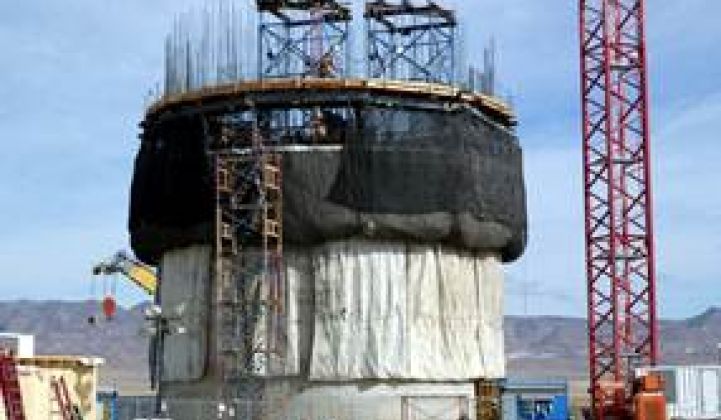SolarReserve’s 110-megawatt Crescent Dunes solar power tower in northern Nevada, with its proprietary multiple-hour molten salts storage capability, is on schedule to go on-line in December 2013. BrightSource Energy’s 370-megawatt Ivanpah solar power tower complex in California’s Mojave Desert, with a proprietary pressurized steam technology, is on schedule to go on-line at about the same time.
Crescent Dunes is backed by a $737 million DOE loan guarantee and holds a 25-year power purchase agreement (PPA) with NV Energy for 100 percent of the electricity. Ivanpah is backed by a $1.63 billion guarantee and has a similar 25-year PPA with California’s PG&E.
Some question the economic viability of concentrating solar power (CSP) technologies -- costs at Crescent Dunes’ were announced at thirteen cents per kilowatt-hour. But builders of these groundbreaking projects say costs will come down with economies of scale and, meanwhile, the PPAs assure repayment of the loans.
“We will pay about $300 million in interest to the U.S. government,” reported SolarReserve CEO Kevin Smith. “The loan guarantee program,” he added, “has been 98 percent successful. The vast majority of borrowers are on course to repay the loans with interest. They will pay, combined, about $8 billion.” The program, he added, “is revenue-generating.”
The U.S. taxpayer “has well over a trillion dollars in similar programs in other technologies,” Smith said. “It is a standard way for government to move policy and technology.” Natural gas fracking technology, he noted, came out of a DOE-funded program.

Backed by $260 million in private equity, the nearly $1 billion Crescent Dunes project started construction in September 2011. “We’ll employ about 600 people at peak construction. There are about 150 on site now. There will be around 4,300 direct, indirect and induced jobs, including suppliers across the U.S. We have now released orders for goods and services in twenty different states.”
Spain’s Sener, Smith said, has an 18-megawatt pilot molten salt power tower project, but Crescent Dunes “is the world’s first commercial-scale facility of its type and will be the flagship project for the industry on molten salt tower storage. It puts us several years ahead of the competition.”
Once operational, he added, Crescent Dunes will have a permanent staff of 45 and an annual operating budget of $10 million that, Smith said, will create several hundred additional indirect and induced jobs.
The construction jobs will, like most construction jobs, Smith acknowledged, be local and will fluctuate. The supply chain will be more dispersed and more fixed. But, Smith said, “it is not only the jobs related to this project but the follow-on jobs. The 150-megawatt Rice project in California is under contract with PG&E. We are going into equity raise and we hope to start construction on that in the second half of 2013. And we have proposed projects in Saudi Arabia, South Africa, Europe, China, Australia, Chile and other markets.”
SolarReserve is planning a combined CSP-photovoltaic (PV) facility as part of Saudi Arabia’s announced $100 billion solar program, Smith said. “We have been active there since early 2011. We have a joint venture executed and in place with a large Saudi infrastructure company.” He declined to provide further details.
“We also have joint ventures in South Africa on the PV and CSP sides,” Smith said. “We have a 150-megawatt PV project under award there and hope to start construction in the next 30 days.”
Though SolarReserve has yet to install PV, the company is also negotiating three PPAs for 100 megawatts of PV projects in California, he added. “It is a relatively simple construction technology and the company has that expertise.”
The firm will use polysilicon panels in South Africa, Smith said, but they are monitoring the markets and considering all PV technologies, including concentrated PV (CPV), for the other projects.

“Our competition is not PV,” Smith said. “It is a complement to CSP. PV is intermittent. Our CSP product, co-designed by Rocketdyne, has energy storage so we can provide firm supply during peak periods and even after dark. Our project in Nevada is expected to run until 10 p.m. or 11 p.m. The Rice project will serve PG&E’s peak demand until 8 p.m. or 9 p.m.”
SolarReserve’s CSP, Smith said, is “an alternative to conventional supply, coal, natural gas and nuclear, because we can operate just like those technologies but without the environmental or waste issues.”
SolarReserve’s most serious competition now is low-priced natural gas, Smith said, but “natural gas is historically a very volatile fuel. As demand increases, natural gas will follow its history. It will be a key fuel, but we will have to deal with that volatility.” CSP, he said, “can eliminate that volatility because we have no fuel requirements and the solar resource has no cost.”
Smith said Governor Romney’s energy plan is “textbook Republican [and] ties itself to Big Oil and natural gas and the nuclear and coal industries. It is disappointing. There are new technologies worldwide. It seems strange that the U.S. would tie itself to older technologies and maintain a dependence on oil.”
Smith declined to predict the election’s outcome. “But I will say that Governor Romney’s energy plan ignores the fact that renewable energy has tremendous support. Polls on renewable energy show 85 percent to 90 percent approval for solar energy and for providing government backing for it. Democrats, Republicans, and Independents support renewable energy.”



